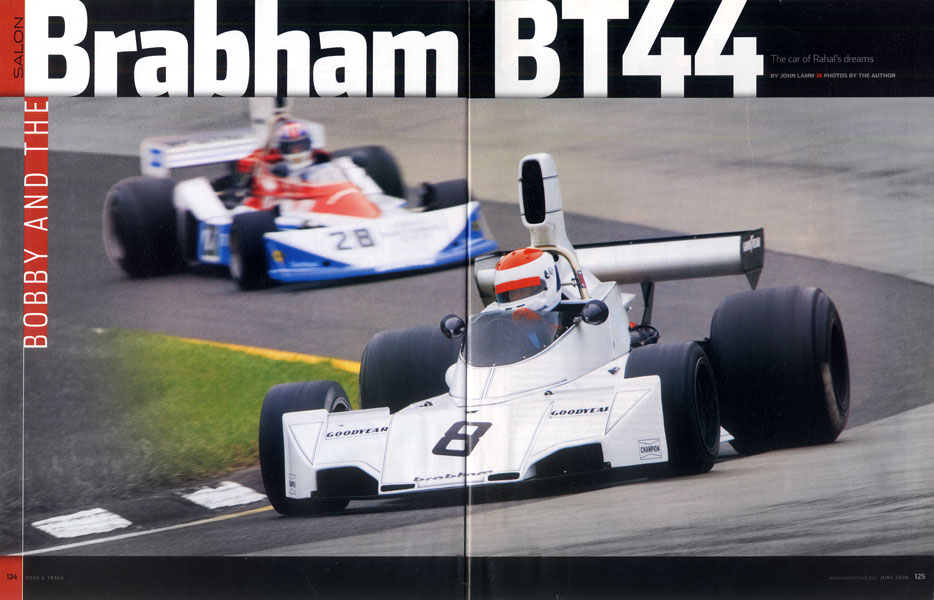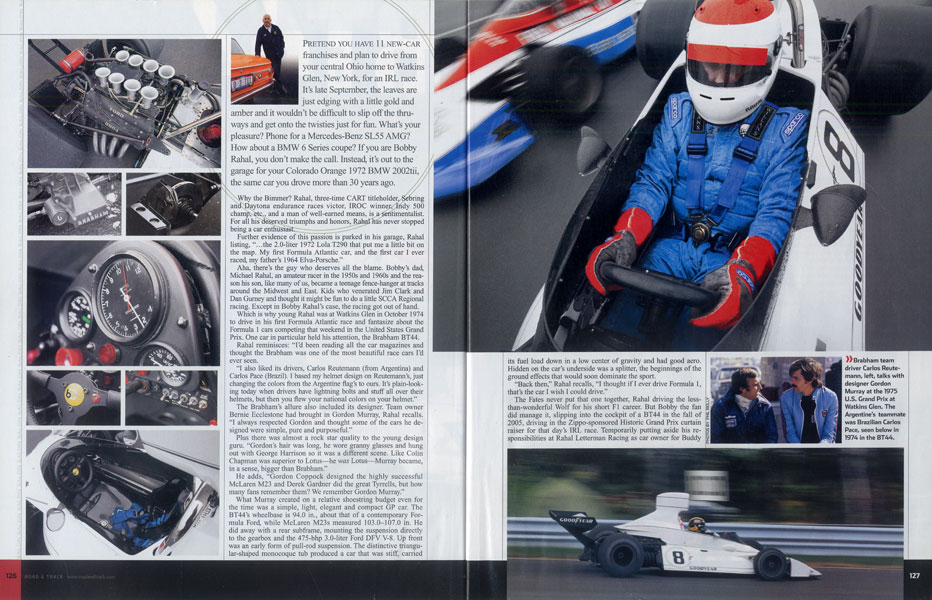



Bobby and the Brabham BT44
The car of Rahal's dreams
Story and Photography by John Lamms

Pretend you have 11 new-car franchises and plan to drive from your central Ohio home to Watkins Glen, New York, for an IRL rae. It's late September, the leaves are just edging with a little gold and amber and it wouldn't be difficult to slip off the thru-ways and get onto the twisties just for fun. What's your pleasure? Phone for a Mercedes-Benz SL55 AMG? How about a BMW 6 Series coupe? If you are Bobby Rahal, you don't make the call. Instead, it's out to the garage for your Colorado Orange 1972 BMW 2002tii, the same car you drove more than 30 years ago.
Why the Bimmer? Rahal, three-time CART titleholder, Sebring and Daytona endurance races victor, IROC winner, Indy 500 hamp, etc., and a man of well-earned means, is a sentimentalist. For all his deserved triumphs and honors, Rahal has never stopped being a car enthusiast.
Further evidence of this passion is parked in his garage, Rahal listing, "...the 2.0-liter 1972 Lola T290 that put me a little bit on the map. My first Formula Atlantic car, and the first car I ever raced, my father's 1964 Elva-Porsche."
Aha, there's the guy who deserves all the blame. Bobby's dad, Michael Rahal, an amateur racer in the 1950s and 1960s and the reason his son, like many of us, became a fence-hanger at tracks around the Midwest and East. Kids who veneratede Jim Clark and Dan Gurney and thought it might be fun to do a little SCCA Regional racing. Except in Bobby Rahal's case, the racing got out of hand.
Which is why young Rahal was at Watkins Glen in October 1974 to drive in his first Formula Atlantic race and fantasize about the Formula 1 cars competing that weekend in the United State Grand Pris. One car in particular held his attention, the Brabham BT44.
Rahal reminisces: "I'd been reading all the car magazines and thought the Brabham was one of the most beautiful race cars I'd ever seen.

"I also liked its drivers, Carlos Reutemann (from Argentina) and Carlos Pace (Brazil). I based my helmet design on Reutemann's, just changing the colors from the Argentine flag's to ours. It's plain-looking today when drivers have lightning bolts and stuff allover their helmets, but then you flew your national colors on your helmet."
The Brabham's allure also included its designer. Team owner Bernie Ecclestone had brought in Gordon Murray, Rahal recalls. "I always respected Gordon and thought some of the cars he designed were simple, pure, and purposeful."
Plus there was almost a rock star quality to the young design guru. "Gordon's hair was long, he wore granny glasses and hung out with George Harrison so it was a different scene. Like Colin Chapman was superior to Lotus --- he was Lotus -- Murray became, in a sense, bigger than Brabham."
He adds, "Gordon Coppock designed the highly successful McLaren M23 and Derek Gardner did the great Tyrrells, but how many fans remember them? We remember Gordon Murray."
What Murray created on a a relative shoestring budget even for the time was a simple, light, elegant and compact GP car. The BT44's wheeelbase is 94.0 in., about that of a contemporary Formula Ford, while McLaren M23s measured 102.0-107.0 in. He did away with a rear subframe, mounting the suspension directly to the gearbox and the 475-bmp 3.0-liter Ford DFV v-8. Up front was an early form of pull-rod suspension. The distinctive triangular-shaped monocoque tub produced a car that was stiff, carried its fuel load down in a low center of gravity and had good aero. Hidden on the car's underside was a splitter, the beginnings of the ground effects that would soon dominate the sport.
"Back then," Rahal recalls, "I thought if I ever drive Formula 1, that's the car I wish I could drive."
The Fates never put that one together, Rahal driving the less-than-wonderful Wolf for his short F1 career. But Bobby the fan did manage it, slipping into the cockpit of a BT44 in the fall of 2005, driving in the Zippo-sponsored Historic Grand Prix curtain raiser for that day's IRL race. Temporarily putting aside his responsibilities at Rahal Letterman Racing as car owner for Buddy Rice and Danica Patrick, Rahal is driving for another owner, vintage race car restoration specialist, Phil Reilly.
Rahal has known Reilly since the mid-1970's and trusts his restoration work, which, one suspects, is crucial when you're about to race the man's car seriously.
And Rahal did just that at the Glen, winning against well-driven, newer equipment. Compared to watching modern F1, IRL or Champ Cars, the vintage machines are more enjoyable, more satisfying because you see the car and driver working in real time, suspension compressed, tires tucked under a bit, movements you see on today's cars only in slo-mo replays.
"Someone said -- and it's a good description -- that cars like the BT44 are like a Formula Atlantic car on steroids," Rahal explains. "The Brabham is nimble and you can drive it sideways, especially in tight corners. It understeers a little bit, but that might be because we haven't tested the car and worked that out. I think the overriding thing is the lightness of the car, as in the steering effort... i'ts a thrill to drive."
Differences with a modern Champ Car or an IRL car? "When I retired [from CART] in 1998, our engines produced around 900 bhp, and this has about half of that, so the sense of power and grip is different. Plus the Brabham is -- in today's sense -- non-ground effect."

Which is more fun to drive?
"My approach is different now," Rahal smiles. "When I was driving Indy cars it was all business. This is all enjoyment, so I come at it from a different perspective. It's fun to try and push th eBT44 to its limits... respecting all the time that it's not my car. But it's such a nice car to drive that you can understand why it did so well."
That would include three GP wins in 1974 and two in 1975, but with enough high placings the second year for the Brabham to finish second in the constructors' championship behind the Niki Lauda-driven Ferrari.
Rahal adds: "I have my last Indy car, which I haven't driven since I got out of it at Fontana. It's got an engine and everything, but I've not driven it and don't really have an interest to do so. Unlike the Brabham and my Lolas, it takes a crew to get modern Indy cars running, and they aren't really nice cars to drive unless you are right on the limit all the time."
Reilly says other retired racers like Eddie Cheever have stopped by to check out the Historic Grand Prix. And one current driver, Dario Franchitti. The week before the Glen race, Rahal (driving a 1963 Ferrari 330 LMB) and Franchitti (in a 1962 lightweight Jaguar E-Tyhpe) duked it out at the Goodwood Revival. Rahal also raced a 1964 Ford Falcon Sprint, happily sliding it around Goodwood's fast corners.
"Most of the people who drive race cars now have no idea what you are talking about," laments Rahal when discussing the history of the sport. "They aren't students or fans. What got me involved in racing was never the idea you could make money. I was hooked. I was a fan... always have been."
And, given the fun he had racing the Brabham, always will be.
